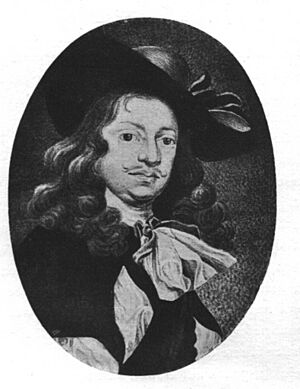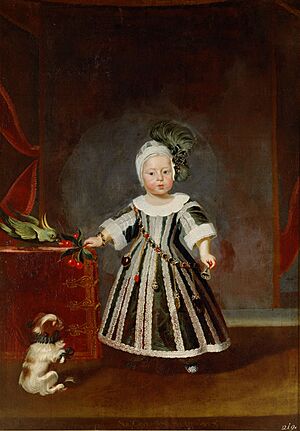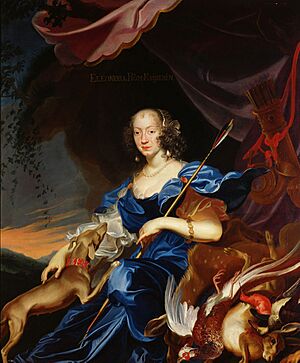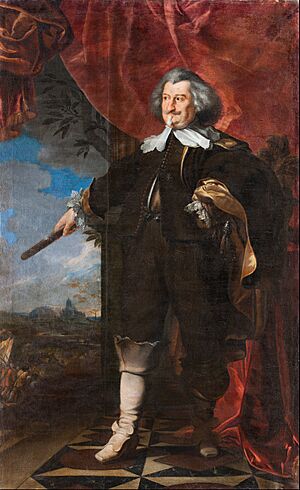Frans Luycx facts for kids
Quick facts for kids
Frans Luycx
|
|
|---|---|

Self-Portrait
|
|
| Born | before 17 April 1604 |
| Died | 1 May 1668 (aged 63–64) |
| Nationality | Flemish |
Frans Luycx (born before April 17, 1604 – died May 1, 1668) was a talented painter from Flanders (a region in modern-day Belgium). He became the main portrait painter for Emperor Ferdinand III in Vienna. Frans Luycx is most famous for his paintings of the Emperor's family and other important members of the Habsburg royal family. This included branches from both Austria and Spain.
Contents
A Painter's Life
Frans Luycx was baptized on April 17, 1604, in Antwerp Cathedral. His father, Adam Luycx, was a silk merchant. In 1618, Frans started learning to paint in the workshop of Remakel Sina. By 1620, he was recognized as a master painter in the Antwerp Guild of Saint Luke. This was an important group for artists. After that, he joined the workshop of the famous painter Peter Paul Rubens.
Becoming a Court Painter
In 1635, Luycx was in Rome, Italy. There, he made connections with important church leaders. He likely also met members of the Austrian Habsburg royal family. His brother, Gerhard, worked at the Viennese court. This might have helped Frans connect with the Emperor's family. His younger brother, Antonius, was also an important church leader in Vienna. Antonius even taught Archduchess Mariana of Austria.
From early 1638, Frans Luycx became the official court painter for the new Emperor Ferdinand III. He earned a good salary and moved to Vienna.
Painting for Royalty
Luycx also had connections with the court of the Polish-Lithuanian King, Władysław IV Vasa. This started around 1637. The Polish king probably visited Luycx's studio in Vienna in 1638. Records show payments to "Leic, painter, for three effigies" (portraits). Before 1643, Polish Prince John Casimir Vasa hired Luycx to decorate his home.
Some of his paintings for the Polish court include portraits of King Władysław IV and his wife Cecilia Renata of Austria. These can be seen in places like Wilanów Palace in Warsaw.
Later Years
Around 1642, Frans Luycx and his two brothers were likely given a special title. From then on, he was sometimes called 'von Luxenstein'. By 1643, he had students or assistants in his workshop. His first wife passed away that year. The next year, he married Eleanora Claurens. She was likely the mother of his three children. His second wife died in 1651 during childbirth.
Between 1648 and 1650, Luycx probably traveled to paint portraits of important rulers. In 1652, he visited his hometown of Antwerp. On June 14, 1654, Luycx married for a third time to Eva Rosina Ottin. The Emperor even gave the couple a wedding gift.
After Emperor Ferdinand III died, Luycx remained a court painter. However, the new Emperor, Leopold I, didn't use his services as much.
Archduke Leopold Wilhelm of Austria became a supporter of Luycx. The Archduke had returned to Austria after being a governor in the Spanish Netherlands. Luycx traveled with the Archduke and stayed with him when he was ill.
Frans Luycx passed away at his home in Vienna on May 1, 1668.
What He Painted
Frans Luycx began his career painting "history subjects." These were often scenes from the Bible or famous historical events. His early works showed the influence of Rubens. However, he soon focused on painting portraits after becoming a court painter.
Famous Portraits
Luycx became well-known for his many portraits of royal families. He painted members of the Habsburg family, especially in Vienna. His paintings were very important, much like those of another painter, Justus Sustermans, in Florence. Luycx paid close attention to how clothes and fabrics looked in his paintings.
Sometimes, his paintings of the same person looked very similar. This was common for court painters who had to paint many portraits. His style in Vienna showed influences from Italian and Spanish art. His compositions were similar to the portraits by the famous Spanish painter Diego Velázquez. Luyckx used similar poses in some of his paintings. You can see this in seven of his portraits in the Museo del Prado in Spain.




